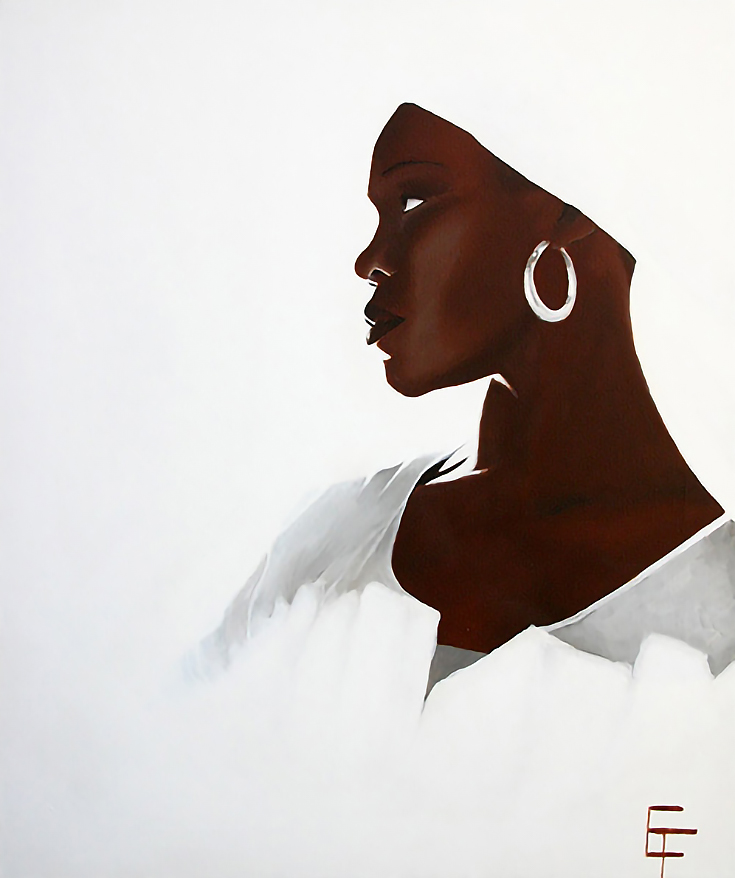 Eric Francis started out painting cartoon characters. He learned everything he could from books and later went on to receive a Bachelor of Arts degree in studio painting from Centenary College in Louisiana.
Eric Francis started out painting cartoon characters. He learned everything he could from books and later went on to receive a Bachelor of Arts degree in studio painting from Centenary College in Louisiana.
After college, painting took a backseat to earning a living. . . that is, until the day he became too ill to work. While he’s healed and healthy now, that downtime allowed Eric to think about his life and what he really wanted to do with it.
Alyice: What’s been your greatest artistic success?
Eric: The ability to create art every day. That might sound a bit corny but it true. For me, a labor of love is a great blessing.
Alyice: Why did you choose acrylic as your medium?
Eric: When I first started painting I used oils. I would go to museums or galleries and see oil paintings. All the great masters used oils and they were who I was trying to be like. Oils had one big drawback, though. . . drying time.
I didn’t really know how to use acrylics but I did some experimenting with them and realized that if I could get a similar look to my oil paintings they would be great.
It was some time after my college days when I did some more experimenting and finding out about the techniques I could use to produce high quality paintings. The results I got were amazing. When I realized that the quality I was getting was as good as any oil paintings I had produced, I was sold.
It is as good for most things and even better for other things because you can control the finish and don’t have to put up with the smell of turpentine or oil. It’s also nontoxic.
Alyice: What is the most challenging part about working with acrylics?
Eric: The most challenging thing about acrylics is also its greatest advantage: drying time. It air dries in minutes so a lot of the traditional wet-on-wet techniques don’t work. You can’t blend because it simply dries too fast.
Acrylic paints also dry dark so you don’t get the color you thought you had when the painting was wet. . . this takes some getting used to. I always premix my paints to see how they look dry before I get them on a canvas because I don’t like any surprises.
Alyice: What is the best part about working with acrylics?
Eric: The best thing about acrylic paints is the drying time. I know I’m contradicting myself but it’s almost instant gratification. When I made oil paintings it would take months for the paintings to dry, but when I paint thin with acrylic paints, it takes minutes.
I also like its versatility. Acrylic paint adheres to so many surfaces from a traditional surface like a canvas or paper to being able to paint murals. It can stick to any porous surface. I have produced acrylic paintings on paper that looks like watercolor. And I can add glass, sand, newspaper print, or anything else that would stick to the paint.
Acrylic polymer film is a clear binder that allows the brilliant color of the pigment to shine through. It won’t become yellow or chip like many of the old master’s paintings do. It’s also a plastic so it expands and contracts to changing weather conditions.
I’m also a big fan of how easy it is to clean up. A little soap and water is all you need.
Alyice: What do you wish you knew about acrylics before you got started?
Eric: I wish I knew that it was a respected medium.
I thought that in order to be a respected painter you needed to paint with oils. All the great masters that I so love (like Vermeer, Rembrandt and Caravaggio to name a few) used oils. Plus, I wish I knew how easy it is to use.
Alyice: Do you do anything in particular to seal your art?
Eric: I don’t use any sealant because it doesn’t need it.
Acrylic, when dry, is unaffected by many liquids so if you spill water on it, it’s not a big deal. In theory it’s not compromised by UV light, either. And if it gets dusty—as all paintings eventually do—you’ll have to get it professionally cleaned.
Alyice: What is your creative process like?
Eric: Every painting begins with an idea. I usually see something that gets my creative juices flowing. It’s a masterpiece I see in my imagination that needs to be extracted from my mind.
The first thing I do is create a sketch where I try to work out the composition and get most of the major details of the subject down. I sometimes make a color sketch on paper where I dilute the paint to watercolor-like consistency. Then I draw my idea with a waterproof pen on watercolor paper and make a painting. This is done to see if my color scheme works.
By the time I am ready to paint, I have a really strong idea about how it is going to look and the direction I’m going to take. I paint almost every day. If I can’t do anything substantial, I write my name. Your signature is a legally binding work of art. If I didn’t want to paint for whatever reason I only need to write my name in a slow and meaningful way. That always gets me going.
Before I begin for the day, I do a simple warm-up. It’s usually a pure contour drawing. My goal is switch my mind over to right brain mode. . . in this mode of perception, painting can be as easy as watching TV. Sometimes I just seem to get in a flow state and it’s wonderful. It becomes difficult to stop and do things like eat and sleep.
Alyice: How has your style changed over the years?
Eric: When I first started, I wanted to be an illustrator. I didn’t change my mind until I took a class trip to the Dallas museum of art. I saw a painting that made me want to explode. I was so excited about it that I never took the time to see who the painter was. But, I remember the painting and the way I felt.
It looked like a perfect thought, like a perfect expression of what was in the artist’s imagination. I knew then that I wanted to spend every day trying to create something that outstanding—even though I didn’t know if I could make something that great.
I didn’t pick up painting until college. In those days I worked on figures—a lot of really cartoony stuff. Now, I mostly stick to portraits and some floral paintings. I can’t truthfully say why I love portraits so much. . . I just know I do.
Nothing in my background before seeing that painting in Dallas would indicate a love for fine arts. Out of the thousand of different things around me, faces grab my attention. I like the challenge of getting a good likeness.
I pick the subjects that I do because of the ideas I have once I see them, then I try to capture a moment, a feeling, an idea.
Alyice: What do you believe is a key element in creating a good composition?
Eric: One important element has to be color. It’s what painting is all about. The right color makes the difference between a good painting and a great one.
I also pay attention to negative and positive space. When you consider negative and positive space you look at the entire picture plane and not just your main subject. . . which results in a more harmonious painting.
Since I mostly do portraits, getting a good likeness is very important too. That means creating sound structure. The entire painting can fall apart because I didn’t take the time to develop good structure.
Alyice: How do you come up with a profitable pricing structure for your acrylic pieces?
Eric: When I began to think about making a living as an artist I realized I had to charge enough to make a comfortable living. Enough to meet my goals.
There are three aspects that go into pricing a work of art: cost of material, time I spend working on it, and size.
It’s easy to keep a records of how long it takes because I work on a schedule. I find that without a schedule my work suffers because I would paint when I felt like it. I know now working on something leads to more creative ideas which then leads to more work. Sitting around waiting for inspiration leads to more sitting around and waiting.
I think about the amount of money I should earn in that time period. I know how much money I want to earn for the year. I break that down into months then I break those months down into weeks. So if I have to do several things in that week or just one thing, I know the amount of money I will get for that time.
If I don’t pay attention to the cost of materials, it can get away from me. Technically, all my paintings are made the same way so it’s easy to guess the cost per painting. For instance, I know how much paint I’m going to use based on the size of the canvas. I do plenty of commissions and I charge per square feet, so when I’m asked to quote a price, I know how much to charge based on size. The size tells me the amount material and the time I’m going to spend making it.
I rarely go down on a quoted price. The art market isn’t bargain shopping. You wouldn’t go to the grocery store and try to bargain for a bag of bread. Instead of going down on price I offer extras like sketches, concept paintings, etc.
Lowering your price is unfair to other people who bought your work at full price—unless you are having a sale. It just doesn’t seem right to me to give everybody a different price based on their skill of negotiation.
You can visit Eric at http://erictfrancis.blogspot.com.
This post may contain affiliate links.




